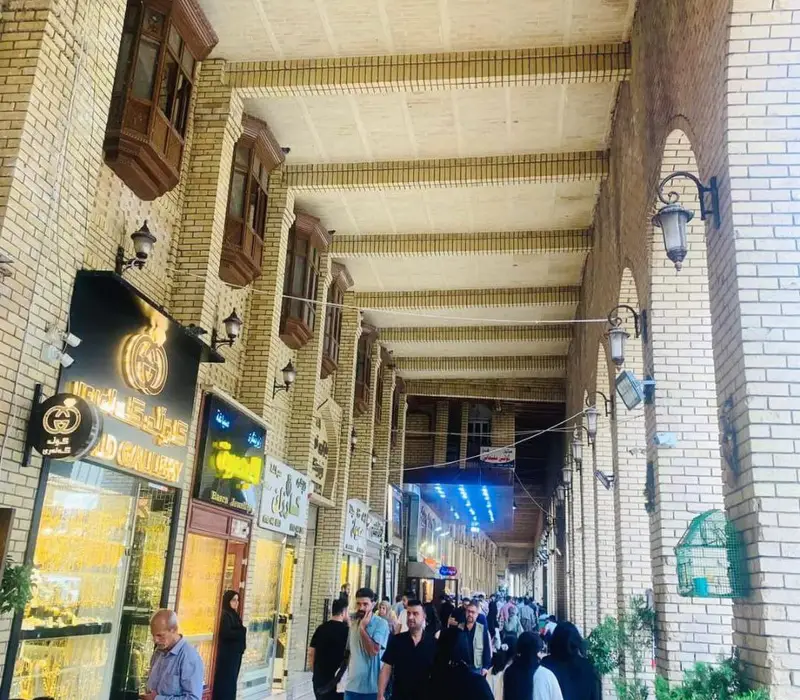The Historical Erbil Qaysari Bazaar: A Gem of Traditional Iraqi Architecture

A Window to Erbil’s Heritage
Nestled in the heart of Erbil, Iraq, and positioned directly across from the famed Erbil Citadel, the Qaysari Bazaar (also known as the Grand Bazaar of Erbil) stands as a living testament to Iraq’s rich cultural and architectural heritage. Its origins trace back to the Ottoman Empire, where it was constructed in a distinctive layout influenced by Latin alphabet shapes. This traditional market, which was rebuilt in 1231-1232 AH (circa 1816-1817 CE) by Haj Qadir Al-Dabbagh, remains a vibrant center of commerce and culture. With its unique architectural features and wide array of shops, the Qaysari Bazaar invites visitors to step back in time while exploring its labyrinthine alleys.
Historical Background of Qaysari Bazaar
The Erbil Qaysari Bazaar dates back centuries, with its layout and design heavily influenced by the Ottoman style. During the Ottoman rule, bazaars were constructed as major trade hubs, linking different regions and people through commerce and culture. The Qaysari Bazaar in Erbil reflects this era’s architectural design, similar to other notable Ottoman bazaars, such as the Hamidiyeh and Midhat Pasha bazaars in Damascus, Syria. The architectural resemblance emphasizes the shared history between Iraq and its neighboring regions.
Architecture and Design of the Qaysari Bazaar
The design of the Erbil Qaysari Bazaar is a marvel of Ottoman architecture. Its layout is complex, built on an elevated and spacious base with intricate pathways leading to two main entrances: one on the south and the other on the west. This structure offers multiple access points and allows for a natural flow of foot traffic within the bazaar. The interior design includes various branching alleys and numerous shops, creating a bustling and vibrant atmosphere. Unique architectural elements, like the ceiling gaps, allow natural light to pour into the market, illuminating the space while providing ventilation.
The design of the market was intended to serve the dual purposes of commercial functionality and aesthetic appeal, creating an environment conducive to both business and community gathering. Its structure, with strategic gaps in the roof, ensures that the marketplace remains well-lit and ventilated, an essential feature for crowded, bustling markets.
Renovation and Preservation Efforts
In recent years, the Qaysari Bazaar underwent a significant restoration process to preserve its original architectural charm. The renovation aimed to maintain the historical essence of the market while ensuring it could meet modern needs. Restoration efforts focused on emulating the original construction style, matching it with the aesthetics of the nearby Erbil Citadel, a UNESCO World Heritage site. The result is a space that not only preserves the traditional marketplace experience but also upholds the cultural legacy of Erbil.
Exploring the Qaysari Bazaar: What to Expect
Visitors to the Qaysari Bazaar can expect a unique shopping experience that combines traditional Iraqi goods with a touch of nostalgia. The market’s extensive variety of shops includes:
Goldsmiths and Jewelers: The bazaar has a dedicated section for gold and jewelry, where skilled craftsmen showcase traditional and modern Iraqi designs.
Spice and Herb Shops: The aroma of spices fills the air, as vendors sell everything from saffron to dried herbs and other local spices essential in Iraqi cuisine.
Sweet Shops and Bakeries: Visitors can taste traditional Iraqi sweets and baked goods, freshly made and sold in various stalls throughout the bazaar.
Food Vendors: A variety of food stalls offer local culinary delights, such as kebabs, grilled meats, and a range of savory and sweet dishes.
Butcher Shops and Grocery Stalls: Local butchers and grocers offer fresh produce, meats, and dairy products, providing a glimpse into everyday Iraqi shopping.
Clothing and Textile Shops: From traditional Iraqi garments to contemporary styles, the market offers a wide selection of clothing and textiles, including fabrics unique to the region.
The market retains its commercial character, providing locals and tourists with a rich assortment of goods while preserving the traditional marketplace atmosphere.
Visitor Information
The Qaysari Bazaar opens its doors to visitors daily, from 8:00 AM to 11:59 PM, providing ample time for exploration. To make the most of a visit, it’s recommended to arrive early, when the market is less crowded, and to take time to explore each section and alleyway fully. The market’s proximity to the Erbil Citadel makes it an ideal stop for tourists who wish to delve deeper into Erbil’s cultural and historical offerings.
Significance of Qaysari Bazaar in Erbil’s Culture
The Qaysari Bazaar is more than just a marketplace; it is a cultural landmark that connects Erbil's past with its present. The bazaar serves as a bridge between generations, where traditional trades and goods are still sold, keeping the heritage of Erbil alive. Additionally, it reflects the city’s resilience and continuity, symbolizing how the people of Erbil preserve their identity and culture through their market traditions.
This significance is not just limited to the local community but extends to the global heritage, as Erbil is one of the world’s oldest continuously inhabited cities. The bazaar, alongside the Erbil Citadel, stands as a proud representation of the city’s enduring spirit and cultural wealth.
How to Get There
The Qaysari Bazaar is located in the center of Erbil, directly across from the Erbil Citadel. For tourists, this proximity to the citadel makes the bazaar easy to access on foot after a visit to the citadel itself. For those unfamiliar with the area, the location can be found on Google Maps, accessible through maps.app.goo.gl6.